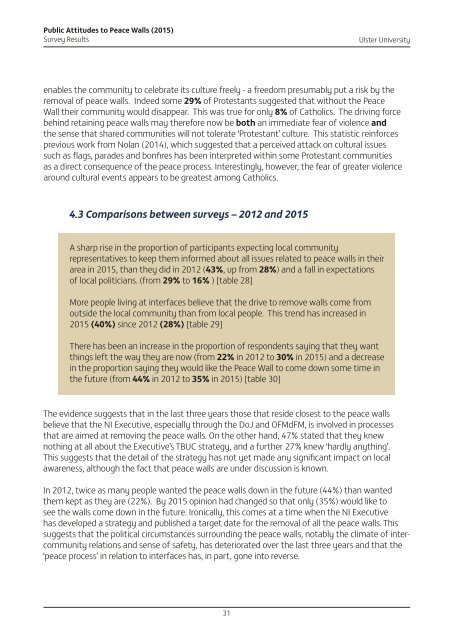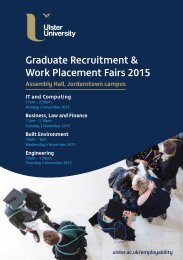Public Attitudes to Peace Walls (2015)
1RRkqqy
1RRkqqy
Create successful ePaper yourself
Turn your PDF publications into a flip-book with our unique Google optimized e-Paper software.
<strong>Public</strong> <strong>Attitudes</strong> <strong>to</strong> <strong>Peace</strong> <strong>Walls</strong> (<strong>2015</strong>)<br />
Survey Results<br />
Ulster University<br />
enables the community <strong>to</strong> celebrate its culture freely - a freedom presumably put a risk by the<br />
removal of peace walls. Indeed some 29% of Protestants suggested that without the <strong>Peace</strong><br />
Wall their community would disappear. This was true for only 8% of Catholics. The driving force<br />
behind retaining peace walls may therefore now be both an immediate fear of violence and<br />
the sense that shared communities will not <strong>to</strong>lerate ‘Protestant’ culture. This statistic reinforces<br />
previous work from Nolan (2014), which suggested that a perceived attack on cultural issues<br />
such as flags, parades and bonfires has been interpreted within some Protestant communities<br />
as a direct consequence of the peace process. Interestingly, however, the fear of greater violence<br />
around cultural events appears <strong>to</strong> be greatest among Catholics.<br />
4.3 Comparisons between surveys – 2012 and <strong>2015</strong><br />
A sharp rise in the proportion of participants expecting local community<br />
representatives <strong>to</strong> keep them informed about all issues related <strong>to</strong> peace walls in their<br />
area in <strong>2015</strong>, than they did in 2012 (43%, up from 28%) and a fall in expectations<br />
of local politicians. (from 29% <strong>to</strong> 16% ) [table 28]<br />
More people living at interfaces believe that the drive <strong>to</strong> remove walls come from<br />
outside the local community than from local people. This trend has increased in<br />
<strong>2015</strong> (40%) since 2012 (28%) [table 29]<br />
There has been an increase in the proportion of respondents saying that they want<br />
things left the way they are now (from 22% in 2012 <strong>to</strong> 30% in <strong>2015</strong>) and a decrease<br />
in the proportion saying they would like the <strong>Peace</strong> Wall <strong>to</strong> come down some time in<br />
the future (from 44% in 2012 <strong>to</strong> 35% in <strong>2015</strong>) [table 30]<br />
The evidence suggests that in the last three years those that reside closest <strong>to</strong> the peace walls<br />
believe that the NI Executive, especially through the DoJ and OFMdFM, is involved in processes<br />
that are aimed at removing the peace walls. On the other hand, 47% stated that they knew<br />
nothing at all about the Executive’s TBUC strategy, and a further 27% knew ‘hardly anything’.<br />
This suggests that the detail of the strategy has not yet made any significant impact on local<br />
awareness, although the fact that peace walls are under discussion is known.<br />
In 2012, twice as many people wanted the peace walls down in the future (44%) than wanted<br />
them kept as they are (22%). By <strong>2015</strong> opinion had changed so that only (35%) would like <strong>to</strong><br />
see the walls come down in the future. Ironically, this comes at a time when the NI Executive<br />
has developed a strategy and published a target date for the removal of all the peace walls. This<br />
suggests that the political circumstances surrounding the peace walls, notably the climate of intercommunity<br />
relations and sense of safety, has deteriorated over the last three years and that the<br />
‘peace process’ in relation <strong>to</strong> interfaces has, in part, gone in<strong>to</strong> reverse.<br />
31




